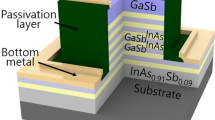Abstract
An InAs/GaSb nBn structure was investigated as a replacement for mercury cadmium telluride (MCT) in long-wavelength infrared (LWIR) and very long-wavelength infrared (VLWIR) detectors, which is advantageous for detection of low-temperature objects. In antimony (Sb)-based III-V compounds, native oxides are easily generated during the process, and these contribute to the surface leakage current. Therefore, a key factor determining device performance is ensuring that native oxides are minimized and the surface is stabilized. Various wet solution-based treatments have been studied. Although wet treatments are effective for surface stabilization, native oxides can be regenerated by subsequent exposure to air or water. In this work, plasma treatments were investigated as an alternative to wet treatment. It was found that hydrogen (H2) plasma treatment effectively reduced the native oxides, and trifluoromethane (CHF3) plasma treatment inhibited the regeneration of the native oxides by coated polytetrafluoroethylene (PTFE) film. The LWIR and VLWIR devices fabricated with these plasma treatments exhibited a dark current density close to MCT rule 07. The proposed plasma treatments could be useful for enhancing the performance of type-II superlattice (T2SL)-based LWIR and VLWIR detectors.







Similar content being viewed by others
References
G.A. Findlay, and D.R. Cutten, Comparison of Performance of 3–5- and 8–12-μm Infrared Systems. Appl. Opt. 28, 23 (1989).
A. Hood, A. Evans, and M. Razeghi, Type-II Superlattice and Quantum Cascade Lasers for MWIR and LWIR Free-Space Communications. Proc. SPIE 6900, 690005 (2008).
T. Kim, H. Lee, J. Bae, and T. Kim, Susceptibility of Combat Aircraft Modeled as an Anisotropic Source of Infrared Radiation. IEEE Trans. Aerosp. Electron. Syst. 52, 5 (2016).
A. Rogalski, M. Kopytko, and P. Martyniuk, Antimonide-Based Infrared Detectors A New Perspective (Bellingham: SPIE Press, 2018).
V. Virkkala, V. Havu, F. Tuomisto, and M. Puska, Native Point Defect Energetics in GaSb: Enabling p-type Conductivity of Undoped GaSb. Phys. Rev. B 86, 144101 (2012).
Y. Guo, and J. Robertson, Chemical Trends and Passivation of Defects at Al2O3: GaAs/InAs/InP/GaSb Interfaces. Microelectron. Eng. 109, 274 (2013).
L. Zhou, B. Bo, X. Yan, C. Wang, Y. Chi, and X. Yang, Brief Review of Surface Passivation on III–V Semiconductor. Curr. Comput.-Aided Drug Des. 8, 226 (2018).
M. Kutty, E. Plis, A. Khoshakhlagh, S. Myers, N. Gautam, S. Smolev, Y. Sharma, R. Dawson, S. Krishna, S. Lee, and S. Noh, Study of Surface Treatments on InAs/GaSb Superlattice LWIR Detectors. J. Electron. Mater. 39, 10 (2010).
A. Gin, Y. Wei, A. Hood, A. Bajowala, V. Yazdanpanah, M. Razeghi, and M. Tidrow, Ammonium Sulfide Passivation of Type-II InAs/GaSb Superlattice Photodiodes. Appl. Phys. Lett. 84, 2037 (2004).
K. Banerjee, S. Ghosh, E. Plis, and S. Krishna, Study of Short- and Long-Term Effectiveness of Ammonium Sulfide as Surface Passivation for InAs/GaSb Superlattices Using X-Ray Photoelectron Spectroscopy. J. Electron. Mater. 39, 10 (2010).
E. Plis, M. Kutty, S. Myers, H. Kim, N. Gautam, L. Dawson, and S. Krishna, Passivation of Long-Wave Infrared InAs/GaSb Strained Layer Superlattice Detector. Infrared Phys. Technol. 54, 252 (2011).
E. DeCuir, J. Little, and N. Baril, Addressing Surface Leakage in Type-II InAs/GaSb Superlattice Materials Using Novel Approaches to Surface Passivation. Proc. SPIE 8155, 815508 (2011).
E. Plis, InAs/GaSb Type-II Superlattice Detectors. Adv. Electron. 246769, 12 (2014).
H. Lee, A. Jang, Y. Kim, H. Jung, P. Bidenko, S. Kim, M. Kim, and J. Nah, Comparative Advantages of A Type-II Superlattice Barrier Over an AlGaSb Barrier for Enhanced Performance of InAs/GaSb Lwir Nbn Photodetectors. Opt. Lett. 46, 16 (2021).
H. Jung, K. Kang, S. Ryu, T. Lee, J. Kim, J. Eom, Y. Kim, A. Jang, H. Lee, Y. Kim, H. Jung, S. Kim, and J. Choi, Investigation of ICP Dry Etching of InAs/GaSb Type-II Superlattice LWIR Photodetector. Proc. SPIE 11741, 11741V (2021).
D. Yun, W. Choi, Y. Park, and B. Hong, Effect of H2 and O2 Plasma Etching Treatment on the Surface of Diamond-Like Carbon Thin Film. Appl. Surf. Sci. 254, 7925 (2008).
L. Ruppalt, E. Cleveland, J. Champlain, S. Prokes, J. Boos, D. Park, and B. Bennett, Atomic Layer Deposition of AL2O3 on GaSb Using in Situ Hydrogen Plasma Exposure. Appl. Phys. Lett. 101, 231601 (2012).
S. Avtaeva, H2 Dissociation in Ar-H2 Arc Discharge of Moderate Pressure. Plasma Res. Express 1, 015018 (2019).
T. Veal, C. McConville, and S. Al-Harthi, Surface Preparation of InAs (110) Using Atomic Hydrogen. Sci Technol 7, 303 (2002).
E. Cleveland, L. Ruppalt, B. Bennett, and S. Prokes, Effect of an in Situ Hydrogen Plasma Pre-Treatment on the Reduction of GaSb Native Oxides Prior to Atomic Layer Deposition. Appl. Surf. Sci. 277, 167 (2013).
NIST X-ray Photoelectron Spectroscopy Database, https://srdata.nist.gov/xps/.
T. Easwarakhanthan, D. Beyssen, L. Brizoual, and J. Bougdira, Spectroellipsometric Analysis of CHF3 Plasma-Polymerized Fluorocarbon Films. J. Vac. Sci. Technol. 24, 1036 (2006).
C. Lee, Y. Pai, J. Zen, and F. Shieu, Characterization of Teflon-Like Carbon Cloth Prepared by Plasma Surface Modification for Use as Gas Diffusion Backing in Membrane Electrode Assembly. Mater. Chem. Phys. 114, 151 (2009).
S. Beckford, Y. Wang, and M. Zou, Wear-Resistant PTFE/SIO2 Nanoparticle Composite Films. Tribol. Trans. 54, 849 (2011).
Acknowledgments
The authors gratefully acknowledge the financial support provided by the Agency for Defense Development and Korea Advanced Institute of Science and Technology in Korea.
Funding
This study was funded by the Agency of Defense Development.
Author information
Authors and Affiliations
Corresponding author
Ethics declarations
Conflict of interest
The authors declare that they have no conflict of interest.
Additional information
Publisher's Note
Springer Nature remains neutral with regard to jurisdictional claims in published maps and institutional affiliations.
Rights and permissions
About this article
Cite this article
Lee, HJ., Kim, Y.C., Eom, J.H. et al. Plasma Treatment for Surface Stabilization in InAs/GaSb Type-II Superlattice LWIR and VLWIR Photodetectors. J. Electron. Mater. 51, 4689–4694 (2022). https://doi.org/10.1007/s11664-022-09703-7
Received:
Accepted:
Published:
Issue Date:
DOI: https://doi.org/10.1007/s11664-022-09703-7




